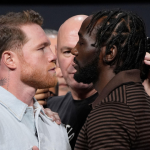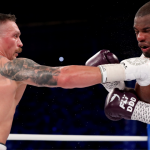THERE are two prevalent attitudes to heavyweight boxing: you are either completely uninspired by Anthony Joshua, Deontay Wilder and Tyson Fury dancing around fighting each other, or you will happily watch them beat up lesser heavyweight characters, comfortable that those big matchups (and the Wilder – Fury rematch) will all work themselves out eventually.
If the majority of fans only care about those three names and that round-robin of matchups it is hard not to feel a little sympathy for Anthony Joshua in Saturday’s matchup because Andy Ruiz is talented, awkward, durable, and has never been knocked out before. In fact, many who watched the Andy Ruiz vs Joseph Parker fight back in 2016 would argue that Ruiz is still as good as unbeaten. Andy Ruiz might well be out-matched by the physical attributes, quality boxing, and thunderous punching power that Joshua brings to the ring, but he is also exactly the sort of fighter who could make Joshua look very disappointing, even in a loss.
Andy Ruiz doesn’t have that “look” that has helped Anthony Joshua catch on as a household name and talk show fixture in the UK. Ruiz doesn’t seem like he was cut from marble and isn’t what anyone imagines when they think “heavyweight champion of the world”. Instead, Ruiz is a continuation of that other great tradition in heavyweight boxing: the fatty with the fast hands.
Despite his decent number of recorded knockouts, Andy Ruiz is not what most would consider a big hitter, at least not when compared to the standouts of his division like Anthony Joshua or Deontay Wilder. In fact, it was quite surprising against Parker, Dimitrenko and Johnson how many clean left hooks Ruiz would score on the side of his man’s jaw as they got caught in exchanging range, and how few of these seemed to shake his opponents’ composure. Another strange feature of Ruiz’s game is the relative inaccuracy of his right hand—often when he steps in to throw it at the right time it seems to fly over his opponent’s left shoulder and, at best, his forearm will slap the side of their neck. This might be because Ruiz—at “just” six-foot-two—often throws his right hand straight and upwards, rather than relying more heavily on the overhand as many stockier heavyweights learn to.
Ruiz’s power might not turn heads at heavyweight, but in his better fights his volume and combination work can. The title bout against Parker was a good example of Ruiz making the most of the surprising conditioning and speed he has at the class. Double jabs, body jabs and right straights to the body all worked as Ruiz attempted to close the distance on his man, even though his right hand seldom found the mark upstairs.
The right straight to the body is one to look out for in particular in this bout. Joshua has four inches of height on Ruiz but that is the same as the height advantage he had against Povetkin and he made it look enormous there. Povetkin’s jab was almost an afterthought as he repeatedly tried to square up and leap in, swinging upwards with the left hook—often being met with the counter jab as he did so. Yet a few of Povetkin’s best connections came as he stepped in with a right straight to the body and Joshua, for whatever reason, stopped moving and was there to be found by the left hook afterwards.
In one pre-fight hype video put together by Eddie Hearn’s people, various talking heads note Ruiz’s height and caution that “punching down” is dangerous for Joshua. There are plenty of examples of short, stocky heavyweights forcing their opponents to punch down to create openings—most famously Joe Frazier, Mike Tyson, Jack Dempsey.
Hell, Archie Moore at forty years old, underweight and dying his hair with boot polish, could still cover up with his cross guard, crouch down deep, and catch his towering opponents with counters as they punched down at him. Charlie Goldman used to say that if you have a short heavyweight you want to make him shorter—have him fight in a crouch and teach him to bob and weave. Ruiz doesn’t fight like that though—in fact if you watch the Parker fight, he spent most of the fight standing on the end of Parker’s reach and parrying punches before entering with body jabs. The body jab is one means of changing level, but it isn’t the kind of slipping and weaving under punches and coming back with counters that some who watched the pre-fight hype pieces might feel they have been advertised.
Here Muhammad Ali punches down at Joe Frazier and eats a left hook for his trouble.
Ruiz’s lack of head movement and level changes, on the whole, could match up interesting with the champ’s arsenal of power punches. Were Ruiz a bobbing, weaving short man the vaunted AJ uppercut would be a constant threat, but it would also open Joshua up to counter left hooks as he threw it. Dimitrenko had success against Ruiz with a lead handed uppercut (as Joshua showed a couple of times against Klitschko), but that was more to do with Ruiz being hunched and stationary than because Ruiz was ducking onto it. Where Ruiz had trouble with Parker was in being caught on the end of the jab and then on occasion by the right hand that followed. On his way up through the ranks, Joshua’s jab quickly became the difference between being a decent banger and an actual boxer-puncher, and if he can establish it well against Ruiz, it seems likely that he will be able to hurt Ruiz more with the right hand following it than the rather cautious Parker was able to.
One more Ruiz look that is worth considering in this bout is his sneaker right hand. A sneaker is a punch delivered on the break from a clinch. Obviously, after the referee has said “break”, you can’t punch your man in the jaw because no matter how unexpected it is, you will get disqualified. But sneakers work when the fighters break the clinch themselves. Ruiz does a terrific job of tucking his elbows and keeping a forearm between himself and his opponent when he gets chest-to-chest. The opponent hugs him, he takes a beat to let them think they’re in control, and then he will turn over a right hook in a few inches of space and it will often do more to break their equilibrium than all of the left hooks he has scored in the fight.
For Ruiz the best gameplan might be to keep the pace high, hit the body whenever possible (where he is considerably more accurate with his power and won’t be swinging up to hit his man). If he can score good left hooks off the right straight or jab to the body, even better. Joshua will likely hold if he’s troubled and Ruiz is flurrying from inside of his reach, at that point Ruiz should be ready to post a forearm or head and make space to either hit the body or score a sneaker and continue flurrying. Keeping the pace up and advancing at all times seems like Ruiz’s best bet, while Joshua’s seems to be putting him on the end of the jab and the right straight, with the occasional uppercut when Ruiz enters. The counter jab as Ruiz steps in could end up being the story of this fight.



